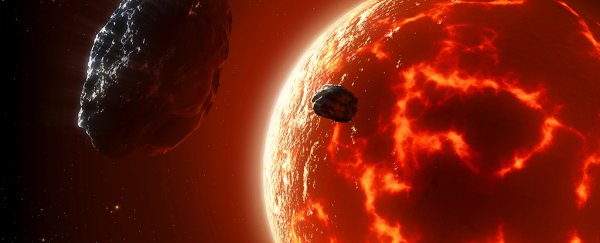Early Earth is often described as 'Hadean' for good reason. Arising from the ashes of a collision that gave us our Moon, the primordial eon was characterized by hellish heat trapped beneath a thick blanket of carbon dioxide and water vapor.
Strangely those conditions should have been inhospitable for far longer than they were. By around 4 billion years ago – following just a few hundred million years or so of cooling – our planet was already starting to look remarkably habitable.
Any explanation of Earth's dramatic transformation would have to take into account the rapid loss of its greenhouse gases, allowing the planet to cool and its water vapor to condense into oceans.
The only problem is that this period in our planet's history left few traces of its geology behind. Scabs of crystallized mineral bobbing about on magma oceans would have long since sunk into the abyss, taking evidence of the planet's surface conditions with them.
So any hypotheses we come up with to solve the mystery of the missing gas have to rely on mostly circumstantial forms of evidence.
Two researchers from Yale University recently ran the numbers on a rather speculative scenario involving 'weird' rocks that no longer exist on Earth's surface, soaking up all that CO2. And the idea seems to check out.
"Somehow, a massive amount of atmospheric carbon had to be removed," says planetary scientist Yoshinori Miyazaki, who is now working at the California Institute of Technology.
"Because there is no rock record preserved from the early Earth, we set out to build a theoretical model for the very early Earth from scratch."
What we know about the Hadean eon on Earth largely comes from astrophysical and geochemical models of planetary formation.
Our Earth-Moon system was most likely the product of a collision between two proto-planets, one roughly Mars-sized and the other more or less the mass of Earth today.
What settled out of that mess of volatiles and rock would have been a molten lump of swirling minerals and gas that was kept warm by a constant downpour of rubble from space.
From these origins, we might imagine a long period of heat and chaos, perpetuated by a greenhouse atmosphere of carbon dioxide and water. One need only look to our neighbor, Venus, to get a sense of what that might look like.
Amid the scant bits of mineral evidence we do have from the Hadean are signs that it already harbored oceans after just a few hundred million years of cooling.
By the eon's end around 4 billion years ago, the carbon cycle seems to have stabilized temperatures to the point life could exist rather happily.
One possibility is that the carbon in the atmosphere could have dissolved into the oceans, transforming into solid carbonates, which could have sunk and become embedded in the mantle's currents.
It's a nice idea, but to even give it half a thought it pays to know if the numbers add up.
So Miyazaki and his colleague Jun Korenaga pulled together models on fluid mechanics, heat movement, and atmospheric physics to see if they could make the hypothesis work.
The results suggest it could … if a certain kind of rock was exposed on our planet's surface.
"These rocks would have been enriched in a mineral called pyroxene, and they likely had a dark greenish color," says Miyazaki.
"More importantly, they were extremely enriched in magnesium, with a concentration level seldom observed in present-day rocks."
A rapidly churning crust of wet, molten rock packed with pyroxene could account for a rapid loss of all that carbon dioxide in a stabilizing process that would take millions, rather than billions of years.
And then, following a cooling that gave us a regenerating crust consisting of a handful of slowly moving plates, all of that magnesium-rich rock would be left far beneath our feet.
As the crust rapidly turned over, water-logged minerals would have quickly dehydrated, filling the oceans to levels we see today.
The scenario is an intriguing one, not least because such a phenomenon would have helped kick-start life in other ways.
"As an added bonus, these 'weird' rocks on the early Earth would readily react with seawater to generate a large flux of hydrogen, which is widely believed to be essential for the creation of biomolecules," says Korenaga.
It's the kind of science that's just begging for hard evidence, which lies buried both deep in time and far under the surface.
No doubt Earth's 'hellish' period will keep its mysteries a little longer. But bit by bit we're coming to an understanding of why our planet became the paradise we see today.
This research was published in Nature.
